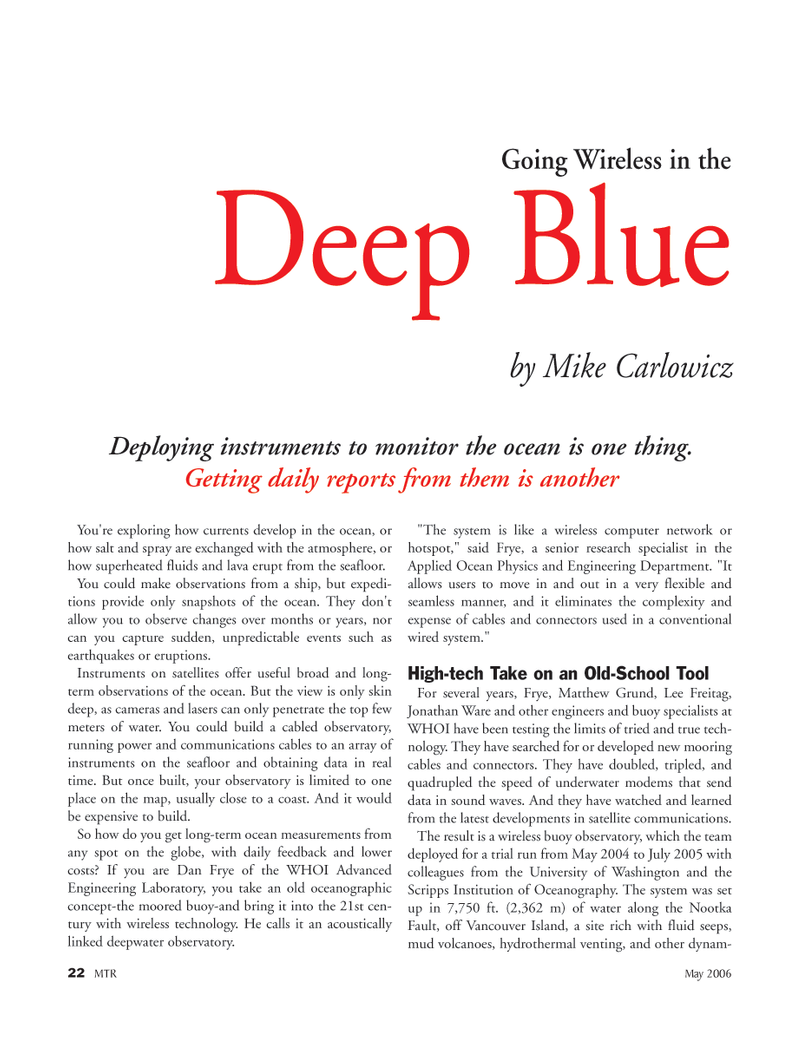
Page 22: of Marine Technology Magazine (May 2006)
The Communications Edition
Read this page in Pdf, Flash or Html5 edition of May 2006 Marine Technology Magazine
22 MTR May 2006
You're exploring how currents develop in the ocean, or how salt and spray are exchanged with the atmosphere, or how superheated fluids and lava erupt from the seafloor.
You could make observations from a ship, but expedi- tions provide only snapshots of the ocean. They don't allow you to observe changes over months or years, nor can you capture sudden, unpredictable events such as earthquakes or eruptions.
Instruments on satellites offer useful broad and long- term observations of the ocean. But the view is only skin deep, as cameras and lasers can only penetrate the top few meters of water. You could build a cabled observatory, running power and communications cables to an array of instruments on the seafloor and obtaining data in real time. But once built, your observatory is limited to one place on the map, usually close to a coast. And it would be expensive to build.
So how do you get long-term ocean measurements from any spot on the globe, with daily feedback and lower costs? If you are Dan Frye of the WHOI Advanced
Engineering Laboratory, you take an old oceanographic concept-the moored buoy-and bring it into the 21st cen- tury with wireless technology. He calls it an acoustically linked deepwater observatory. "The system is like a wireless computer network or hotspot," said Frye, a senior research specialist in the
Applied Ocean Physics and Engineering Department. "It allows users to move in and out in a very flexible and seamless manner, and it eliminates the complexity and expense of cables and connectors used in a conventional wired system."
High-tech Take on an Old-School Tool
For several years, Frye, Matthew Grund, Lee Freitag,
Jonathan Ware and other engineers and buoy specialists at
WHOI have been testing the limits of tried and true tech- nology. They have searched for or developed new mooring cables and connectors. They have doubled, tripled, and quadrupled the speed of underwater modems that send data in sound waves. And they have watched and learned from the latest developments in satellite communications.
The result is a wireless buoy observatory, which the team deployed for a trial run from May 2004 to July 2005 with colleagues from the University of Washington and the
Scripps Institution of Oceanography. The system was set up in 7,750 ft. (2,362 m) of water along the Nootka
Fault, off Vancouver Island, a site rich with fluid seeps, mud volcanoes, hydrothermal venting, and other dynam-
Going Wireless in the
Deep Blue by Mike Carlowicz
Deploying instruments to monitor the ocean is one thing.
Getting daily reports from them is another
MTR#4 (17-32).qxd 5/8/2006 9:53 AM Page 22

 21
21

 23
23
